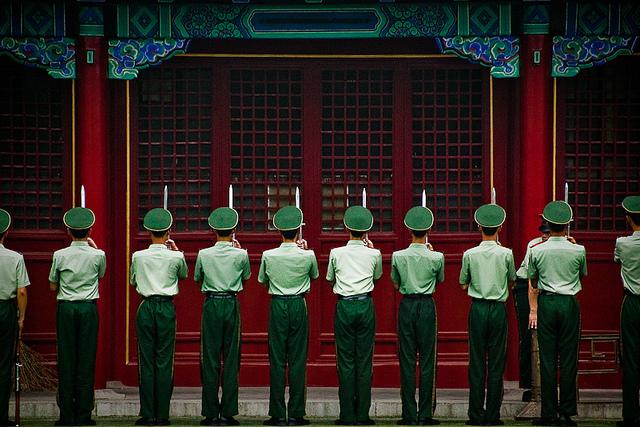Is China ready to resume its imperial glory?
Posted By Feng Zhang on September 18, 2015 @ 06:00
Since assuming the Chinese Communist Party (CCP) leadership in November 2012, Chinese president Xi Jinping’s great ambitions have become well known. Domestically, he’s advanced the grand goal of what he calls the China Dream: ‘the great rejuvenation of the Chinese people’. He has surprised virtually every observer by the speed and efficiency with which he’s consolidated power in the party and military. Xi is now seen as China’s most powerful leader after Deng Xiaoping, if not Mao Zedong.
The two major pillars of Xi’s assertive foreign policy—security activism predominately in the maritime domain, and economic diplomacy by way of the so-called ‘one belt, one road’ policy—suggest that Xi isn’t content with making China a great power in the region and beyond; he also wants to make China a leading and even dominant power in key areas of Asia–Pacific regional relations. Indeed, as a keen student of history, Xi may be trying to restore the role of China in the contemporary East Asian system to its historical height during the era of the Chinese empire (221BC–1911AD).
Is Xi’s China ready to resume the glory of its imperial predecessor? We may compare China today with China during the early Ming dynasty (1368-1424), which achieved an incomplete regional hegemony in East Asia. By GDP, the economic position of Ming China at the height of its power was stronger than that of the US today. But hegemony is about more than material capabilities—it’s the conjunction of material primacy and social legitimacy; the ability to control important international outcomes and some degree of consent and acceptance from other states in the system.
Early Ming China’s neighbours adopted four principal strategies in their response to and dealings with the Ming imperial court. Ranked from the most to the least cooperative, these four strategies are identification, deference, access, and exit. Almost all of Ming China’s neighbours adopted a strategy of deference, whereby they deferred to, but didn’t necessarily accept as legitimate, imperial China’s hierarchical scheme of foreign relations embodied by the tribute system.
Ming China thus only achieved an incomplete hegemony in East Asia. But that’s hardly surprising: every hegemony is incomplete, even in the case of contemporary US hegemony. Ming China never had to confront a systemic, anti-hegemonic response in the form of, say, a counterbalancing coalition characteristic of modern European politics. On the whole, early Ming China’s material primacy in East Asia was also a Chinese hegemony accepted by its neighbours to varying degrees.
An important criterion for measuring Chinese influence today is the type and nature of regional responses to China’s rise. None of China’s neighbours are developing a strategy of identification, not many states are adopting one of deference either. The main strategy adopted by most states today is in fact access, an instrumental attempt to maintain relationships with China in order to obtain economic benefits from China’s rise. Some are also adopting a strategy of exit by downgrading their relationships with China or by switching to closer relationships with other countries, including China’s archrival, the US.
The contrast with early Ming China is thus clear and striking. Whereas Ming China succeeded in making deference the major regional strategic response to its power, with a nice addition of identification from Korea, today’s China has only achieved the level of an access strategy, and it is in fact struggling with a number of countries even at that level. Moreover, whereas Ming China never had to face a counterbalancing coalition from its neighbours, such balancing is a constant spectre for today’s China. Current Chinese foreign policy leaves much to be desired, and the PRC still has a long way to go before reaching the glory of its imperial predecessor—if indeed it can ever reach such heights.
The problem isn’t with the trajectory of China’s development, which is still largely sound and positive, but rather, it’s with the ways in which some Chinese policymakers and analysts perceive China’s strengthening position in the international order and how that power should now be used. A palpable sense of triumphalism emerged in some segments of the Chinese policy and intellectual community after the country’s success through the Global Financial Crisis. Yet, as a senior scholar in Beijing pointed out to me, overestimation of China’s power is much more harmful to China’s interests than underestimation. China faces serious economic headwinds and the constraints on Beijing’s foreign policy have consequently tightened over the past few months. President Xi’s foreign policy remains in search of a foundation, a purpose and an effective strategic approach.
Chinese foreign policy has now entered an important stage of multiple changes and adjustments, and is open to be shaped by a variety of domestic and international factors. It will be wise for Chinese leaders to take a long-term historical perspective when considering the potential of Chinese influence in the region and the limits of current approaches. If they are really historically minded, the strategic goals of China’s Asia–Pacific policy should include both a positive and negative goal—a positive goal of encouraging a new kind of deference from regional states appropriate to the norms and conditions of 21st century world politics, and a negative goal of preventing an implicit or explicit counterbalancing coalition forming against China. Whether they can achieve those goals will depend heavily on their strategic wisdom and foresight.
Article printed from The Strategist: https://aspistrategist.ru
URL to article: /is-china-ready-to-resume-its-imperial-glory/
URLs in this post:
[1] Image: https://aspistrategist.ru/wp-content/uploads/2015/09/5402496607_c677a59e24_z.jpg
Click here to print.
